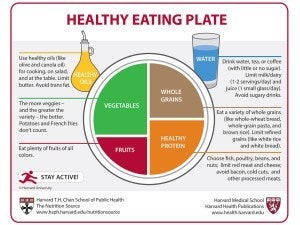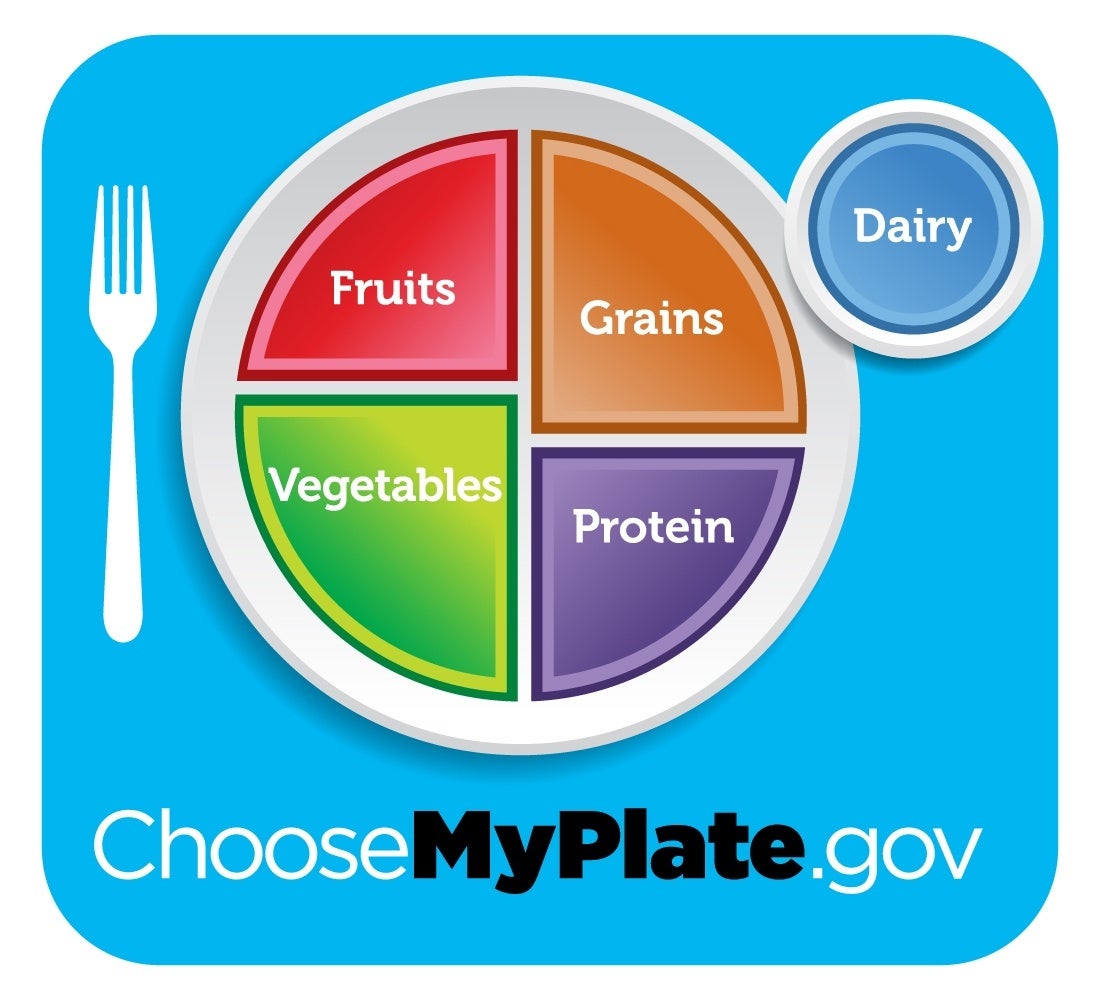The Healthy Eating Plate, created by experts at Harvard T.H. Chan School of Public Health and Harvard Medical School, points consumers to the healthiest choices in the major food groups. The U.S. Department of Agriculture’s (USDA) MyPlate, though it has been revised to reflect some key findings, still doesn’t offer the most complete picture when it comes to basic nutrition advice.
The Healthy Eating Plate is based exclusively on the best available science and was not subjected to political or commercial pressures from food industry lobbyists. Here’s a table showing how the Healthy Eating Plate compares to the USDA’s MyPlate, section by section.

|
|
| Whole Grains | Grains |
| The Healthy Eating Plate encourages consumers to choose whole grains and limit refined grains, since whole grains are much better for health. In the body, refined grains like white bread and white rice act just like sugar. Over time, eating too much of these refined-grain foods can make it harder to control weight and can raise the risk of heart disease and diabetes. Read more about the health benefits of whole grains. | Although initially MyPlate did not tell consumers that whole grains are better for health, it has since been revised to suggest that consumers make at least half of their grains whole grains – an important update! |
|
Healthy Protein |
Protein |
| The Healthy Eating Plate encourages consumers to choose fish, poultry, beans or nuts, protein sources that contain other healthful nutrients. It encourages them to limit red meat and avoid processed meat, since eating even small quantities of these foods on a regular basis raises the risk of heart disease, diabetes, colon cancer, and weight gain. Read more about the benefits of choosing healthy protein. | MyPlate’s protein section could be filled by a variety of sources, including a hamburger or hot dog. Though the plate has been revised to suggest that adult consumers eat at least 8 ounces of cooked seafood per week, it still offers no indication that red and processed meat are especially harmful to health. |
| Vegetables | Vegetables |
| The Healthy Eating Plate encourages an abundant variety of vegetables, since Americans are particularly deficient in their vegetable consumption—except for potatoes and French fries. Potatoes are chock full of rapidly digested starch, and they have the same effect on blood sugar as refined grains and sweets, so limited consumption is recommended. Read more about the benefits of vegetables. | MyPlate does not distinguish between potatoes and other vegetables. |
|
Fruits |
Fruits |
| The Healthy Eating Plate recommends eating a colorful variety of fruits. Read more about the benefits of fruits. | MyPlate also recommends eating fruits. |
|
Healthy Oils |
(Not included in MyPlate) |
| The Healthy Eating Plate depicts a bottle of healthy oil, and it encourages consumers to use olive, canola, and other plant oils in cooking, on salads, and at the table. These healthy fats reduce harmful cholesterol and are good for the heart, and Americans don’t consume enough of them each day. It also recommends limiting butter and avoiding trans fat. Read more about the benefits of healthy fats and oils. | MyPlate is silent on fat, which could steer consumers toward the type of low-fat, high-carbohydrate diet that makes it harder to control weight and worsens blood cholesterol profiles. |
|
Water |
Dairy |
| The Healthy Eating Plate encourages consumers to drink water, since it’s naturally calorie free, or to try coffee and tea (with little or no sugar), which are also great calorie-free alternatives. It advises consumers to avoid sugary drinks, since these are major contributors to the obesity and diabetes epidemics. It recommends limiting milk and dairy to one to two servings per day, since high intakes are associated with increased risk of prostate cancer and possibly ovarian cancer; it recommends limiting juice, even 100% fruit juice, to just a small glass a day, because juice contains as much sugar and as many calories as sugary soda. Read more about water and other healthy drinks, and learn about calcium, milk and health. | MyPlate recommends dairy at every meal, even though there is little if any evidence that high dairy intakes protect against osteoporosis, and there is considerable evidence that too-high intakes can be harmful. As for sugary drinks, MyPlate says 100% fruit juice counts as part of the Fruit Group. |
|
Stay Active |
(Not included in MyPlate) |
| The figure scampering across the bottom of the Healthy Eating Plate’s placemat is a reminder that staying active is half of the secret to weight control. The other half is eating a healthy diet with modest portions that meet your calorie needs. Read more about the benefits of staying active. | There is no activity message on MyPlate. |
Related
- Learn more about the Healthy Eating Plate
- Read the press release about the Healthy Eating Plate launch on September 14, 2011.
Last reviewed February 2023
Terms of Use
The contents of this website are for educational purposes and are not intended to offer personal medical advice. You should seek the advice of your physician or other qualified health provider with any questions you may have regarding a medical condition. Never disregard professional medical advice or delay in seeking it because of something you have read on this website. The Nutrition Source does not recommend or endorse any products.
